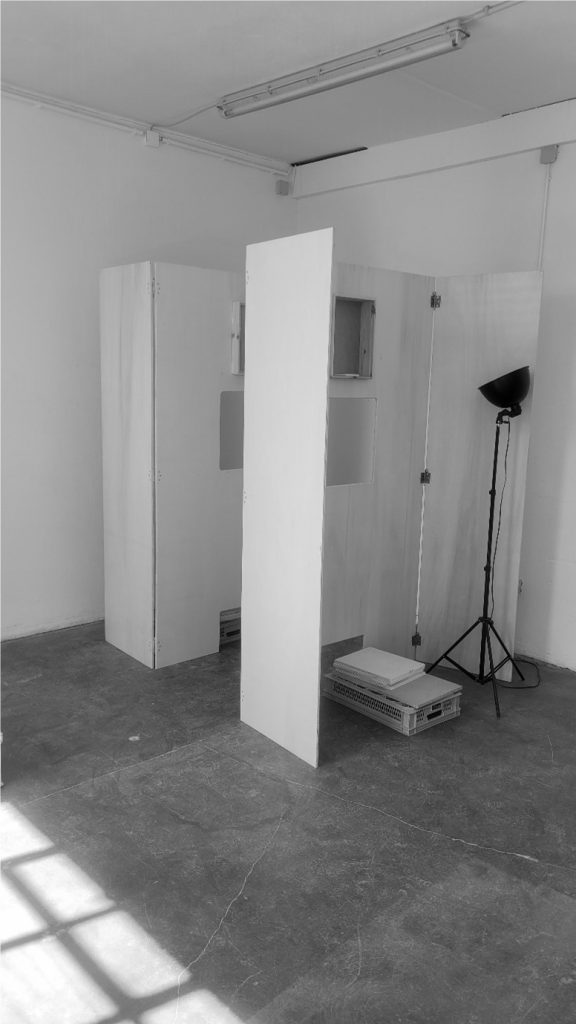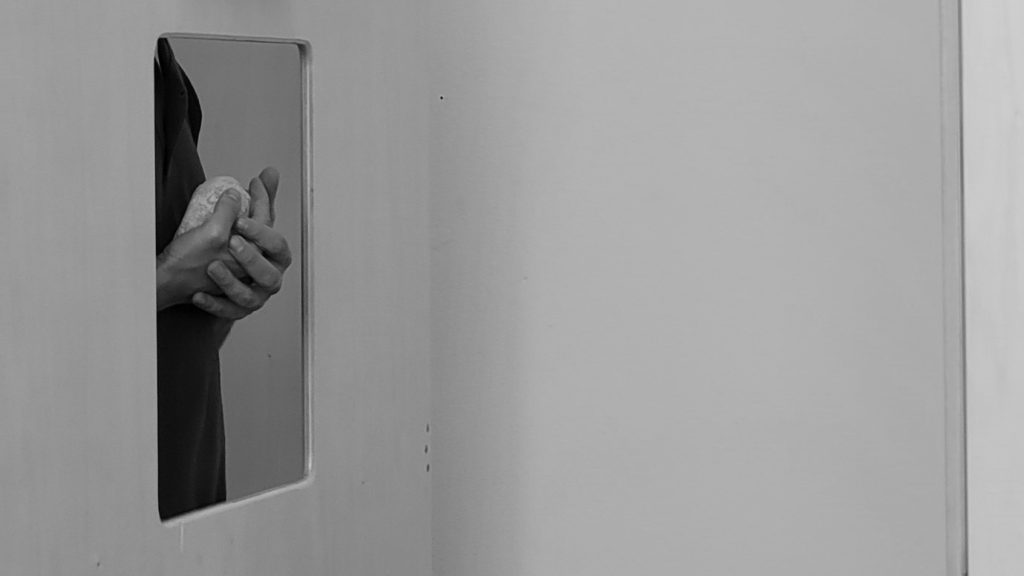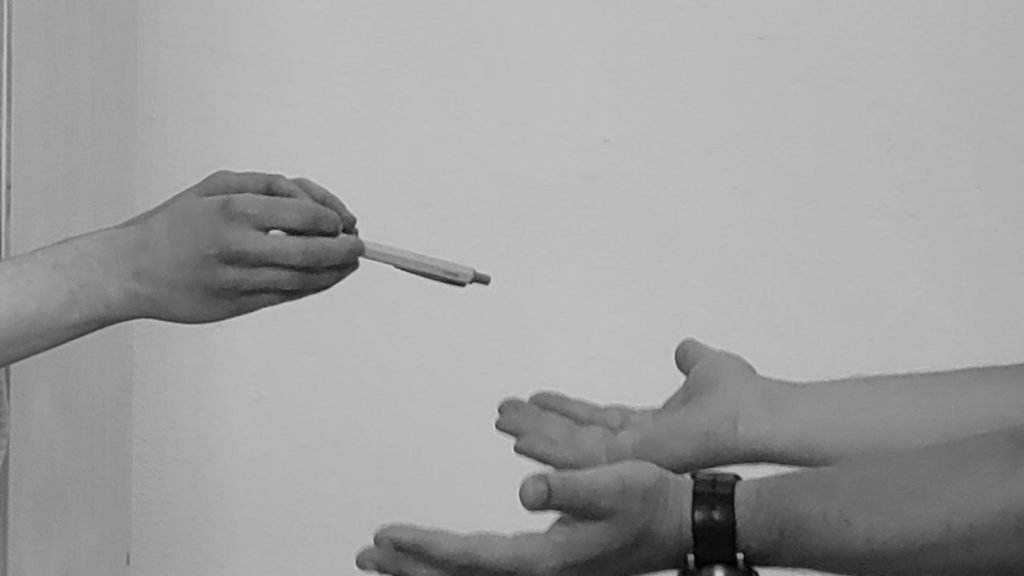The global politics of give and take: a workshop with Susanne Schütte-Steinig and Sabine Sörgel in two parts
sabine sörgel
Image 1: In lieu of the audience: the gaze of the touch-spectre
Our performance workshop started from the premise of ‘give and take’ in the global dynamics of social and economic exchange to investigate the notion of ‘dis:connect’ from a phenomenological perspective. By emphasising sensual touch in the encounter with personal objects, we sought to abstract from the visual and intellectual engagement that is often the focus of such transaction in other contexts. The debates on the restitution of art objects from the Global South to their countries of origin was also at the back of our minds, yet we did not want to make this our direct and obvious starting point. Rather, we sought to address some of those issues at a micro-level of interhuman exchange and communication.
Our shared interest in objects and hands also arose from a common background in yoga, meditation and somatic practice. We both wondered about how such practices affect communication and how we cope with the global intersections of contemporary crises, as the wider consequence of the many so-called darker sides of global modernity and racial colonial capitalism.
Our initial conversations started over socially distanced walks and coffees in the Englischer Garten. Susanne Schütte-Steinig soon showed me a sketch of two wooden boxes facing each other closely resembling a basic puppet theatre. Except that in this case, the puppeteers use their own hands only, whilst their bodies are held in upright stillness, resting their chin on a soft foam pad, legs shoulder-width apart in a relaxed posture, with their pubic bone just underneath the open window facing their partner on the opposite side (Image 1, 2 and 4).[1]
Image 2: The somatic “box set”
That sketch ended up depicting the position held by our workshop participants for several heartbeats a couple of months later, half-way through my research fellowship. And whilst each participant centred their hands on their chest, focusing their attention inwards before offering their object for exchange, I wondered about the shadows of globalisation in that empty space (Image 4).
Part one: interviews at global dis:connect
Image 3: A sprocket cassette from Taiwan
Interviews are a common method in various types of research, including oral histories, anthropology and history. They are also a common feature of the TV and social-media world, and many of us will have sweated through an interview as the final hurdle to getting their dream job. However, our artistic workshop was not particularly interested in any of these interview techniques and formats. Rather, the focus was to be solely directed towards the object itself, as well as the gestures of the hands holding it.
The objects were therefore initially chosen by each participant with the following instruction:
- Bring a personal object related to your current research project, either an archival source or an everyday tool, that is indispensable to the way you work at your best.
Later in the artistic process, this instruction was modified to say that the object would have to be three dimensional and fit between two hands and no larger than a laptop screen, for the practical reason that it had to fit through the window set-up as well, as we became more and more interested in the idea of being able to hold something of personal value in your actual hands from both a kinetic and felt-energetic perspective. Some of the interview questions arose from my academic research on the Jungian notion of the shadow to investigate the darker aspects of globalisation, as those repressed parts of the Western European psyche run havoc in the present shaping of contemporary crises, from the resurfacing of unaddressed systemic racism to the extraction of resources and climate change. The aim of the interview was thus to interrogate the extent to which Europe itself, and perhaps academia and academics more than others, must question many commonplace Enlightenment values and liberties, which have historically been built on the exclusion and exploitation of human and non-human ‘sources of life’ from the Global South.[2]
Susanne’s artwork, on the other hand, addresses some of these questions through her practice in dance and architecture to investigate the in-between space of encounter through the performative engagement with objects she designs and choreographs as set spatial scores and actions. Through dance and body work, we each had a point of reference that connected us throughout the initial conversations on the theme of ‘give and take’ that led to the following set of interview questions for the workshop participants:
- Why did you become a historian (researcher)?
- Why did you choose to bring this object?
- What is your fondest memory of visiting an archive?
- What is your relationship to the European Enlightenment?
- Did you ever experience theft, steal something or was something stolen from you?
The interviews were planned so as to meet our participants in our everyday work surroundings at the global dis:connect offices and to introduce the object as a personal object closely tied to both the researcher’s sense of self as well as their profession and research.
As a researcher at global dis:connect, I was very aware of the risks this workshop was asking my colleagues to take. A professional habitus is hard to acquire, difficult to shed and marks so much of our market value as humanities researchers in the contemporary world. Therefore, we were careful to create an open situation of mutual trust that would make it very difficult for the researcher to automatically fall into their default academic habitus of presenting themselves through an elaborate talk or paper, but rather to give us an impromptu and spontaneous response of no more than three to four unprepared sentences.
Such initial thoughts and associations, as a matter of fact, enabled an open encounter with the participants’ objects as a form of disconnect rather than a carefully crafted argument that would usually have to be closed to persuade. It was thus that I hoped to get hold of the shadow aspects entailed in this form of presentation. On the day of the interviews, we had four participants from global dis:connect share their objects and responses, whilst the camera captured the ‘handling of the object’ in a posture of care no wider than the camera frame between lap and top and the gestures one makes in this sacred space between the pelvis (lap) and the heart (top).
Part two: the Yoga of talking hands
Hand on your heart, are you ready to give your object?
Disconnected from our everyday working environment, the invitation to Susanne’s Atelier in Munich’s Baumstraße offered the researchers an opportunity for a performative encounter with each other and our objects in a different setting. The day was sunny and two more members of global dis:connect were able to join us, as they had recovered from a Covid-19 infection the previous week. In their cases, we had no accompanying interview to go with but only their yoga of hands.
Not unlike the European Enlightenment, yoga practice has also journeyed across the globe into our living rooms and local gyms. Yet, as a practice it predates the European Enlightenment by centuries and perhaps is the more sophisticated for it. Although many people around the world practice yoga and meditation these days, there is still a tendency to consider these spiritual and physical activities separate – as separate as is the body from the mind, even now, for some of us brought up in a false sense of neutral objectivity grounded in notions of Enlightenment philosophy and the split that was supposedly created there.
In this second part of the workshop, it was our chance to break with the Enlightenment conventions of European research and bring these disconnected spheres of research and artistic practice together. With the help of the artist’s skill to re-connect the disconnected through her theatrical set-up, we hoped to shed some light on the shadow aspects of global exchange practices in other realms.
And as each participant entered Susanne’s installation, they found themselves no longer able to hide behind elaborate words or even in a photographic representation of themselves as in aesthetic realism, because all but their hands touching was withheld from their own view. In this vulnerable moment, the hands started talking their own language, as they were led by the energy of the individual heartbeat.
The Yoga of Hands and the Space In-Between
The wounded researcher
A week after the workshop, I listened again to the interviews in search of the shadows of our hidden thoughts, those truths we so often do not dare to speak. This is to say that in each of our thoughts there is always a disconnect from all that is not thought in that moment so that an in-between space marks this shadow area that is always also at work in thought processes. As Merleau-Ponty continues to explain this idea in an essay called The Philosopher and his Shadow:
Just as the perceived world endures only through the reflections, shadows, levels, and horizons between things (which are not things and are not nothing, but on the contrary mark out by themselves the fields of possible variation in the same thing and the same world), so the works and thoughts of a philosopher are also made of certain articulations between things said.[3]
These ‘certain articulations between things said’ are now captured in the yoga of hands and the silent negotiation that takes place in the in-between encounter of Susanne’s edited film of this performative installation in two parts. Deprived of their elaborate wordings, the researchers in this project opened themselves to become vulnerable to the essence of touch. This in-between space holds, for me, the colon in the conceptual idea of the centre’s name: ‘Dis:connect’ then offers an opportunity to account for the shadow aspect of that absence, which is only made visible by all that is not seen much less explained, but merely felt in an instance of touch.
[1] There is no audience in the conventional sense, only the camera (alias ‘The Touch-Spectre’), which zooms in on the exchange of hands and the space in/between. No one claps, the beginning and end are decided by the two participants only and guided by Susanne’s movement instructions and action score.
[2] Achille Mbembe addresses this point in several of his works and the term ‘sources of life’ reflects on the energetic and creative essentials of living that have been sacrificed to the necropolitical project of Western colonial modernity whilst they remain a constant source also for the rebuilding of new African subjectivities.
[3] Maurice Merleau-Ponty, Signs (Chicago: Northwestern University Press, 1964), 160.
Bibliography
Bourdieu, Pierre. Outline of a Theory of Practice. Cambridge: Cambridge University Press, 1977.
Hicks, Dan. The Brutish Museums. The Benin Bronzes, Colonial Violence and Cultural Restitution. London: Pluto Press, 2020.
Iyengar, B.K.S. Light on the Yoga Sūtras of Patañjali. London: Thorsons, 1993.
Mauss, Marcel. The Gift. The Form and Reason for Exchange in Archaic Societies. London/New York: Routledge, 1990.
Mbembe, Achille. Critique of Black Reason. Durham: Duke University Press, 2017.
Merleau-Ponty, Maurice. Signs. Chicago: Northwestern University Press, 1964.
Mignolo, Walter. The Darker Side of Western Modernity. Global Futures, Decolonial Options. Durham: Duke University Press, 2011.
Priyamvada, Gopal. ‘On Decolonization and the University’. Textual Practice 35, no. 6 (2021): 873–99.
Romanyshyn, Roman. The Wounded Researcher. Research with Soul in Mind. London/New York: Routledge, 2013.
Savoy, Bénédicte. Africa’s Struggle for Its Art. History of a Postcolonial Defeat. Princeton: Princeton University Press, 2022.
Schütte-Steinig, Susanne. Going to Paradise. München, 2022. www.sss333.de.










